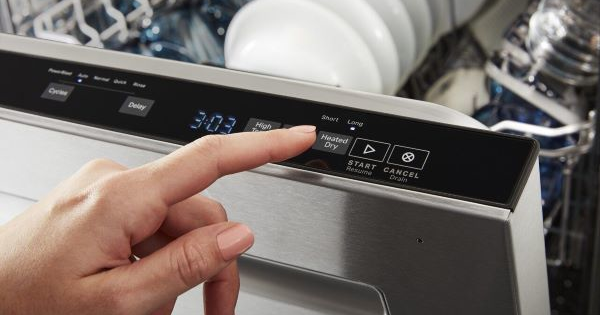
Are you staring at dishwasher product descriptions and wondering what "Mega FanDry Pro" actually means? Do customer reviews constantly mention complaints about a dishwasher's drying performance? You're in the right place. We're going to cover how dishwashers dry your dishes, how they've changed from the dishwashers of the early 2000s, and how to tell if your dishwasher is drying normally or if something might be wrong with it.
Table of Contents:
- How Dishwashers Dry Dishes
- How to Find a Dishwasher That Dries Well
- Is My Dishwasher Drying Properly, or Is Something Wrong?
How Dishwashers Dry Dishes
All dishwasher drying technology boils down to three basic methods.
- Condensation Dry: Uses the physics of condensation to pull moisture off dishes.
- Fan-Assisted Dry: #1, plus air circulation to help things along.
- Heated Dry: Add a separate heating element to heat the air so moisture evaporates off dishes.
Condensation dry is one of the most common drying methods on today's dishwashers. Here's how it works:
- The dishwasher rinses the dishes with very hot water, which makes the dishes hot.
- The (ideally stainless steel) dishwasher tub cools faster than the dishes.
- The cooler material "draws" the hot, moist air. The moisture condenses on the sides of the tub.
This method works best with stainless steel interior tubs because plastic tubs take longer to cool down - and condensation occurs when the tub surface is cooler than the dishes and interior air of the dishwasher. It doesn't work as well on plastic items, either, for the same reason.
Fan-assisted dry adds a little fan, usually near the door of the dishwasher, to help circulate the air. They may have a hidden door vent to help draw moisture out of the tub. In theory, this improves drying performance. In practice, it varies between models.
Heated dry used to be the only method for drying dishes: a heating element in the bottom of the dishwasher. This was especially necessary with older dishwashers that had plastic tubs. However, the heating elements could melt plastic items in the lower rack.
Bosch CrystalDry is an innovative take on traditional heat dry that doesn't rely on electricity to create heat. Instead, CrystalDry uses a mineral that produces heat when exposed to moisture.
All dishwashers dry dishes with one or a combination of these methods.
How to Find a Dishwasher That Dries Well
- Know what to expect. Glass and metal items should be dry enough to put away, but plastics might need to sit in a drying rack or get a quick wipe-down with a towel. Water will collect in coffee mug bottoms, the rims of plastic containers, etc. Be aware that a 1-hour wash/quick wash cycle will have worse drying performance.
- Get a dishwasher with a stainless steel interior tub. If you're on a budget, Bosch's cheapest $500 models have stainless tub walls and a plastic base. Stainless steel tubs have other benefits over plastic tubs, too, like durability, stain-resistance, and odor-resistance.
- Check out third-party reviews that test the product. For example, Consumer Reports now includes a standardized drying test. In my opinion, relying solely on customer reviews is risky. People are more likely to share a negative experience than a positive or neutral one.
And to improve your dishwasher's drying performance, consider the following:
- Rinse Aid. Rinse Aid is mostly known for reducing water spots on glassware, but it also helps pull water off of your dishes in general.
- Open the door at the end of a cycle. This makes condensation drying more effective.
Is My Dishwasher Drying Properly, or Is Something Wrong?
If your dishwasher's drying performance has gotten worse, there might be something wrong with the dishwasher.
If the problem is intermittent, the issue could be due to the dishwasher, but it's also worth checking your hot water heater settings and making sure that hot water is available when the dishwasher is run. Lack of hot water can cause dishwashers to run longer and worsen their drying performance.
If you're wondering if your new dishwasher is drying properly or not, here's what's normal:
-
The Quick Wash/1-Hour Wash cycle will have worse drying performance, or won't dry dishes at all
-
After a Normal/Auto cycle...
-
Glass and metal items should be dry enough to put away
-
Plastics might need to sit in a drying rack or get a quick wipe-down with a towel
-
-
Water will collect in coffee mug bottoms, the rims of plastic containers, etc
If everything is dripping wet at the end of a Normal/Auto cycle, that makes it more likely there is something wrong with the dishwasher.


